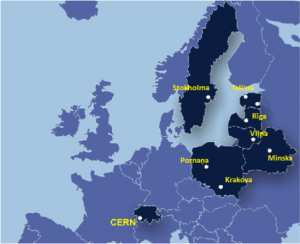BalticGrid-II
In May 2008, the BalticGrid-II was launched. This project was a part of the Seventh EU Framework Programme and lasted until 30 April 2010. Aiming at extending and developing the e-Infrastructure of the Baltic States built during the first phase of the BalticGrid, the project included these tasks:
- to include Belarus in the BalticGrid infrastructure;
- to ensure interoperation of the gLite-based infrastructure with UNICORE and ARC Grid resources in the Baltic Region;
- to engage new scientific communities in using Grid resources in nanoscience and engineering, for example;
- to establish new Grid services for linguistic research, Baltic Sea environmental research, data mining tools for modelling.
The e-Infrastructure created within the BalticGrid-II project is fully interoperable with the pan-European e-Infrastructures and the European Grid Initiative. e-Infrastructure of 26 clusters was built in five countries during the first phase of the BalticGrid, and the second phase strived to grow its computing resources both in capacity and capability.
The BG-II consortium is composed of 13 leading institutions in seven countries, with 7 institutions from the Baltic States, 2 — from Belarus and Poland, and one — from Sweden and Switzerland. In the second phase of the BalticGrid, Latvia was represented by RTU Faculty of Electronics and Telecommunications and Institute of Mathematics and Informatics of the University of Latvia.
The e-Infrastructure developed within the BalticGrid-II was mainly applied in particle physics, linguistics, bioinformatic and biomedical visualisation, and modelling of the Balti Sea ecosystem.
About the Grid
Grid is one of the e-science tools for solving complex scientific problems, which provides access to large computing resources owned by various organisations or even located in different countries. Middleware and fast Internet has allowed combining of these resources in one infrastructure thus resulting in a single high-powered computing machine. Unlike the so-called desktop grid which uses regular computers during the idle time, this grid employs special technology which is usually held by university data centres — mainframes or supercomputers, computing clusters, and data storage facilities. Grid infrastructure may also include various scientific instruments, like telescopes, sensors and other modern equipment, that contribute to more convenient and accessible research possibilities.
The first project phase was launched from scratch at the end of 2005. The pioneers — Oļģerts Belmanis, Lauris Cikovskis and Jānis Kūliņš, later accompanied by Artis Šteinbergs and Zigmārs Strods — were led by the professor Ilmārs Slaidiņš. The team started out studying and researching the Grid technologies which were little-known at that time, later the first servers were purchased resulting in a cluster of five computing nodes. As the number of servers grew, central Grid services and 16 cores for computation were offered, as well as 1 TB of Grid data storage at the end of the first project phase.

